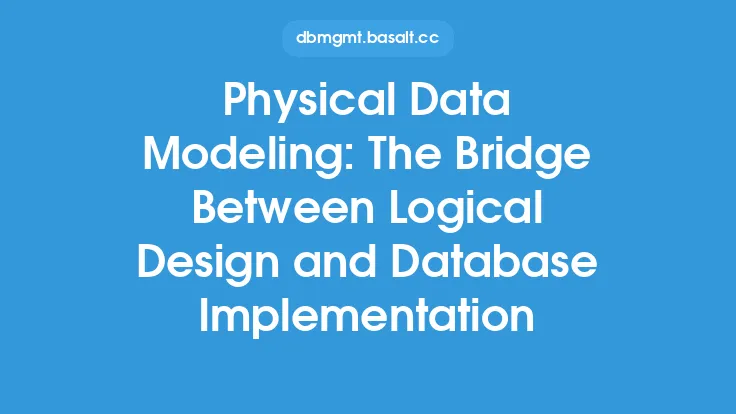Physical data modeling is a crucial step in the database design process, serving as a bridge between the conceptual and logical design phases. It involves creating a detailed, implementation-specific model of the database, taking into account the physical storage and performance requirements of the system. In this article, we will delve into the fundamentals of physical data modeling, exploring its key concepts, techniques, and best practices.
Introduction to Physical Data Modeling
Physical data modeling is a critical component of the database design process, as it provides a detailed, implementation-specific model of the database. This phase of design focuses on the physical storage and performance requirements of the system, ensuring that the database is optimized for data retrieval, storage, and manipulation. Physical data modeling involves creating a model that is tailored to the specific database management system (DBMS) being used, taking into account its unique features, limitations, and constraints.
Key Concepts in Physical Data Modeling
There are several key concepts that are essential to understanding physical data modeling. These include:
- Data types: The specific data types used to store data in the database, such as integers, strings, and dates.
- Data storage: The physical storage mechanisms used to store data, such as disk storage, solid-state drives, and tape storage.
- Indexing: The use of indexes to improve data retrieval performance, including the types of indexes, such as B-tree and hash indexes.
- Partitioning: The division of large tables into smaller, more manageable pieces, to improve performance and reduce storage requirements.
- Denormalization: The intentional deviation from normalization rules to improve performance, by reducing the number of joins required to retrieve data.
Physical Data Modeling Techniques
There are several techniques used in physical data modeling, including:
- Table design: The design of individual tables, including the selection of data types, indexing, and partitioning.
- Index design: The design of indexes, including the selection of index types, and the optimization of index performance.
- Storage design: The design of storage systems, including the selection of storage devices, and the optimization of storage performance.
- Data distribution: The distribution of data across multiple storage devices, to improve performance and reduce storage requirements.
- Data compression: The use of compression algorithms to reduce the storage requirements of data, and improve data transfer performance.
Best Practices for Physical Data Modeling
There are several best practices that should be followed when creating a physical data model. These include:
- Follow database design principles: The physical data model should adhere to established database design principles, such as normalization, and data integrity.
- Optimize for performance: The physical data model should be optimized for performance, taking into account the specific requirements of the application, and the characteristics of the data.
- Consider data storage and retrieval: The physical data model should take into account the physical storage and retrieval requirements of the system, including the selection of data types, and indexing strategies.
- Use data modeling tools: The use of data modeling tools, such as entity-relationship diagrams, and data modeling software, can help to create a physical data model that is accurate, and consistent.
- Test and refine the model: The physical data model should be tested, and refined, to ensure that it meets the requirements of the application, and performs optimally.
Common Challenges in Physical Data Modeling
There are several common challenges that are encountered when creating a physical data model. These include:
- Balancing performance and storage: The physical data model must balance the need for high performance, with the need for efficient storage, and data retrieval.
- Managing data complexity: The physical data model must manage the complexity of the data, including the relationships between entities, and the data types used to store data.
- Ensuring data integrity: The physical data model must ensure that the data is accurate, and consistent, by implementing data integrity constraints, and validation rules.
- Optimizing for scalability: The physical data model must be optimized for scalability, to ensure that the database can handle increasing amounts of data, and user traffic.
- Managing data security: The physical data model must manage data security, by implementing access controls, and encryption, to protect sensitive data.
Conclusion
Physical data modeling is a critical step in the database design process, providing a detailed, implementation-specific model of the database. By understanding the key concepts, techniques, and best practices of physical data modeling, database designers can create a physical data model that is optimized for performance, storage, and data retrieval, and ensures the integrity, and security of the data. Whether you are a seasoned database designer, or just starting out, physical data modeling is an essential skill that is required to create a well-designed, and functional database.





